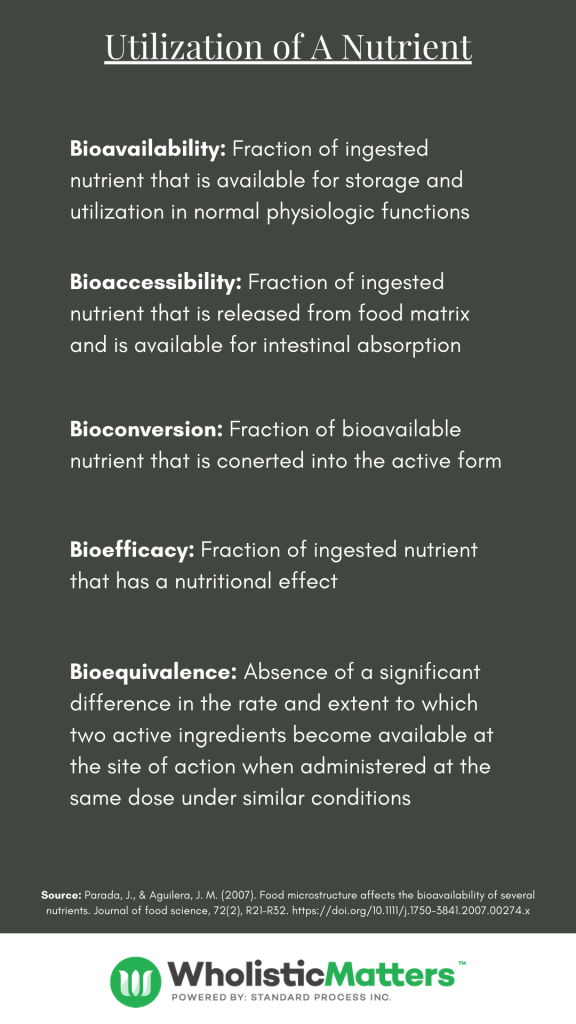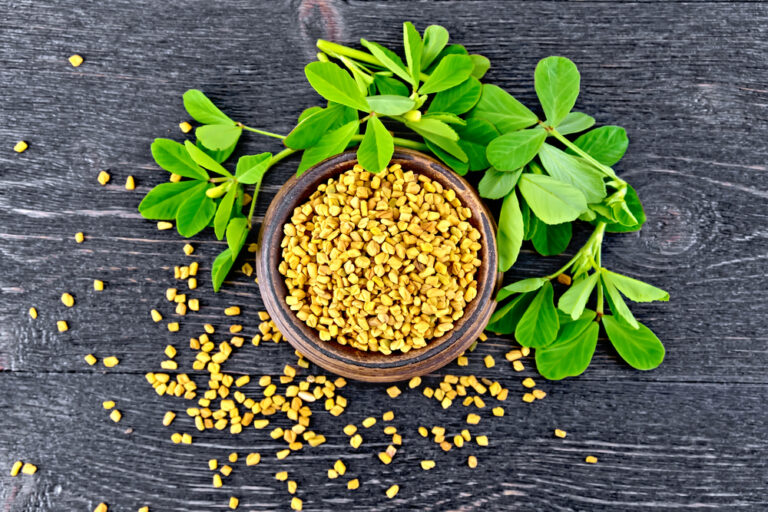Nuance in the Utilization of a Nutrient
What good would highly nutritious foods be if the nutrients couldn’t be absorbed or accessed properly after a meal? Several complex measures can depict how “ready for use” nutrients from food may be. These measures can help build an understanding of how intricate, particular, and nuanced nutrition science can be.
Two key measures of nutrient status upon consumption are bioavailability and bioaccessibility. While sometimes these terms are used interchangeably, the subtle differences in their meaning are important to understand how nutrients make their way into the circulation for dispersal and use.
What is Nutrient Bioavailability?
Nutrient bioavailability is the rate, proportion, and extent to which the active substances or therapeutic components of food are absorbed and become available after digestion at a specific site.1 Specific nutrient bioavailability is associated with the efficiency of absorption and metabolic utilization of an ingested nutrient or phytochemical.
Moreover, a nutrient is considered “bioavailable” if it is able to be used once ingested to perform its mode of action in the body in the relevant region of interest.1
For example, the main bioactive component in turmeric is curcumin. Curcumin has shown tremendous bioactive potential in cell culture and animal models for anti-inflammatory and overall health promoting action. However, the bioavailability of this compound in humans has shown to be very low due to its extreme insolubility.2 To aid in the bioactive availability of curcumin, many different approaches have been developed to enhance delivery, including the design and development of nanoparticles, self-assemblies, nanogels, liposomes, and complex fabrication.3
What is Nutrient Bioaccessibility?
Nutrient bioaccessibility is the fraction of a compound that is released from its complex food structure (matrix) and potentially available for further uptake and absorption.4 Bioaccessibility can shelter some “otherwise digestible” compounds from aspects of digestion to a degree that allows them to reach different starting points for metabolism or even bypass it altogether.4
For example, starch is simply chains of glucose linked together, but the way it is bound up in a cereal grain (type 1) or the way it is linked in a crystalline structure (types 2 and type 3) make it unable to interact with digestive enzymes that are perfectly capable of breaking down normal glucose chains. This creates a less bioaccessible resistant starch that bypasses digestion, reaching the lower GI tract to feed microbes.
Through technology advancements, scientists can create man-made bioaccessibility changes by enclosing therapeutic agents within a capsule designed to bypass salivary enzymes and/or the highly acidic environment of the stomach following ingestion, where the environment could disrupt the active components. This allows the capsule and its contents to reach a different part of the GI tract that is its intended absorption point. In this way, the accessibility impacts the function or bioavailability.
Is More Bioavailability and Bioaccessibility Always Healthier?
When looking at health benefits, bioavailability and bioaccessibility can work both beneficially and negatively. When bioactive and bioaccessible components are beneficial, receiving more of them allows for an observable benefit to the individual consuming them. For example, it would be advantageous for vitamins and minerals consumed in the diet to be both bioavailable and bioaccessible, especially for someone who is deficient in a particular nutrient.
However, there are certain times when bioavailability and bioaccessibility are clearly not advantageous. Hypothetically, if there are trace levels of toxic heavy metals in a plant or in seafood and they are more bioavailable than normal, toxic heavy metals might be accumulating in the body more efficiently than normal if someone consumes that plant as food.
And sometimes, the clear benefit or disadvantage from increased bioavailability and bioaccessibility may not be apparent. For individuals with metabolic issues, increased availability of carbohydrates can cause problematic blood glucose levels, insulin spikes, and weight gain. 4 If these carbs are less bioaccessible, as is the case in many resistant starches, then they are less able to be broken down and absorbed in the body. This is part of why resistant starches are uniquely health promoting. But when an individual is trying to access energy quickly for something like an athletic event, then the interest would be in having available nutrients for fueling activity.
What Factors Make Something More or Less Bioavailable or Bioaccessible?
Many different features impact the bioavailability and bioaccessibility of plant compounds; some are natural to the plant, and others depend on physical interactions: 4
- Natural food matrix
- Post-harvest processing
- Mixture with other foods
- Cooking and preparation
There are also internal features of the human body that affect bioavailability and bioaccessibility:
- Mastication (chewing)
- pH (acidity)
- Enzymatic activity
- Microbial activity
What is the Whole Food Matrix?
The whole food matrix is one of many factors that contribute to a nutrient’s bioavailability. The idea of the “whole food matrix” is best described as a physical domain that contains and/or interacts with specific constituents of a food (e.g. a nutrient), facilitating functionalities and behaviors that are different from those exhibited by the same components found in isolation or a free state.5
Nutritional supplements may harness the power of the whole food matrix by pairing nutrients and bioactive compounds that synergize to perform functions. Additional benefits may include slowing down delivery of some nutrients and helping many nutrients bypass digestion to feed good bacteria.
Is Nutrient Bioavailability Influenced by Whether or Not A Nutrient Is in a Whole Food Matrix?
Bioavailability is influenced by whether the nutrient is isolated or unaltered from within a whole food matrix. But how exactly this influence works is something that varies wildly depending on the nutrient and the greater specifics of the food matrix itself.
One great example of the complexity of this question is found in the health promoting glucosinolate compounds from brassica vegetables like kale, Brussels sprouts, and broccoli.6 Within the plant, glucosinolates are stored as an inactive sugar-bound form compartmentalized and protected from breakdown. The moment the plant matrix is disrupted by chewing or cutting, the sugar-bound glucosinolates interact with a degradation enzyme called myrosinase that quickly converts the glucosinolates into the bioactive isothiocyanates. So if the plant is ground up – through whatever type of initial processing – and allowed to sit, then all of the glucosinolates convert to isothiocyanates, the bioactive, but less stable compound that is readily degraded.
For brassica plants, the structure of the food matrix and the subsequent processing greatly affects the bioavailability of health promoting substances. There are a few ways a person could gain the benefits of compounds like glucosinolates in brassica vegetables through the diet.
- Consume raw plants to ensure quick delivery of bioactive glucosinolates into the body.
- Inactivate enzymes through thermal degradation. Cooking plants inactivates enzymes and preserves intact glucosinolates.
- Freeze-dry plants to retain plant structure. Freeze-drying removes water without damaging the plant; freeze drying lowers water activity to the point that the interaction between the enzymes and the glucosinolates cannot occur even as the plant is ground. Whole food, plant-based supplements utilize freeze-drying to preserve bioactive compounds like glucosinolates.
In the whole food matrix, things that are “nutrients” for humans are necessary for biological functions to plants. So the components are all functional, stored in ways that the living source can utilize them when needed.
Iron is a specific essential mineral where the whole food matrix effect can greatly influence bioavailability. In nuts, cereals, and legumes the mineral is plentiful; however, it winds up having a low bioavailability due to the presence of phytic acid, an ester of inositol found in plants that binds minerals, forming phytates, to be used by the plant as a storage form for minerals, including iron to be used by growing seedlings. When these high phytate foods are consumed the mineral bound complexes are difficult for humans to digest and absorb since they lack phytase enzymes that can break this, leading to a much lower bioavailability for iron from these seeds.7
This is contrary to iron from animal muscle tissue where there is heme iron that comes as part of hemoglobin and myoglobin and is estimated to be absorbed 15 to 35 percent more readily. The whole food matrix in animal muscle contains a multitude of small peptides, glycosaminoglycans, and L-a-glycerophosphocholine, all thought to play a role in increasing iron bioavailability.8
Nutrient Bioavailability & Bioaccessibility and the Whole Food Matrix
Making sense of bioavailability and bioaccessibility as important concepts for understanding the whole food matrix is a vital step toward acknowledging the intricate nuances in how the human body utilizes nutrients. The good news is this: the elaborate distinctions between different nutrients and how they become available for use in the body doesn’t change the fundamental understanding of the importance of whole, plant-based foods for human health.
Parada, J., & Aguilera, J. M. (2007). Food microstructure affects the bioavailability of several nutrients. Journal of Food Science, 72(2), R21–R32. https://doi.org/10.1111/j.1750-3841.2007.00274.x
- Hatcher, H., Planalp, R., Cho, J., Torti, F. M., & Torti, S. V. (2008). Curcumin: from ancient medicine to current clinical trials. Cellular and Molecular Life Sciences, 65(11), 1631–1652. https://doi.org/10.1007/s00018-008-7452-4
- Purpura, M., Lowery, R. P., Wilson, J. M., Mannan, H., Münch, G., & Razmovski-Naumovski, V. (2018). Analysis of different innovative formulations of curcumin for improved relative oral bioavailability in human subjects. European Journal of Nutrition, 57(3), 929–938. https://doi.org/10.1007/s00394-016-1376-9
- Bohn, T., McDougall, G. J., Alegría, A., Alminger, M., Arrigoni, E., Aura, A. M., Brito, C., Cilla, A., El, S. N., Karakaya, S., Martínez-Cuesta, M. C., & Santos, C. N. (2015). Mind the gap-deficits in our knowledge of aspects impacting the bioavailability of phytochemicals and their metabolites–a position paper focusing on carotenoids and polyphenols. Molecular Nutrition & Food Research, 59(7), 1307–1323. https://doi.org/10.1002/mnfr.201400745
- Aguilera J. M. (2019). The food matrix: implications in processing, nutrition and health. Critical Reviews in Food Science and Nutrition, 59(22), 3612–3629. https://doi.org/10.1080/10408398.2018.1502743
- Barba, F. J., Nikmaram, N., Roohinejad, S., Khelfa, A., Zhu, Z., & Koubaa, M. (2016). Bioavailability of Glucosinolates and Their Breakdown Products: Impact of Processing. Frontiers in Nutrition, 3, 24. https://doi.org/10.3389/fnut.2016.00024
- Reddy, N. R., & Sathe, S. K. (2002). Food phytates. Boca Raton, FL: CRC Press.
- Hurrell, R., Egli, I. (2010). Iron bioavailability and dietary reference values. The American Journal of Clinical Nutrition, 5, 91. https://doi.org/10.3945/ajcn.2010.28674F








